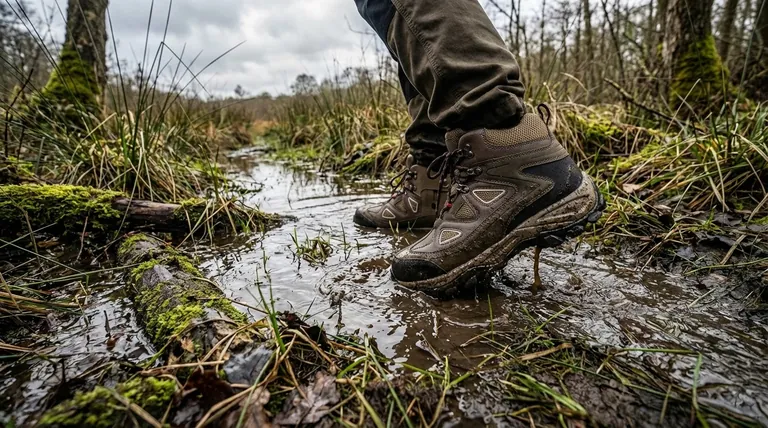The primary limitation of snake boots in wet environments is their tendency to leak. While many are marketed as "waterproof," their construction often fails to maintain water resistance over time, especially with the repeated flexing and stress of walking through consistently wet or swampy terrain.
The core issue is a conflict in design priorities. Snake boots are engineered first for puncture resistance against fangs, a goal that can compromise the long-term flexibility and seam integrity required for truly reliable waterproofing.

The Primary Challenge: Waterproofing Failure
The most significant drawback of snake boots in damp conditions is their eventual failure to keep your feet dry. This issue stems from both materials and construction.
Why "Waterproof" Isn't Always Waterproof
A boot's waterproof claim often relies on a membrane lining and sealed seams. With the stiff materials required for snake protection, the constant creasing and stress from walking can wear down these elements, creating small points of failure where water can seep in.
The Impact of Saturation
Once a snake boot is saturated, it becomes a liability. The thick materials take a very long time to dry, leading to heavy, waterlogged footwear that significantly increases discomfort and the risk of blisters or other foot ailments on long treks.
Beyond Leaks: Secondary Limitations in Wet Terrain
Even before a leak occurs, the inherent design of snake boots presents challenges when used as all-purpose footwear in wet environments.
The Weight Factor
Snake boots are characteristically heavy due to the dense, protective materials. This weight is compounded when the boots become wet, leading to faster fatigue compared to standard hiking boots.
Comfort and Fit
The rigidity required for bite protection can make achieving a perfect, comfortable fit difficult. An improper fit that causes minor rubbing on a dry day can quickly lead to painful blisters when your feet are damp and the boot material is less forgiving.
Understanding the Trade-offs: Protection vs. Practicality
Choosing snake boots involves weighing their primary safety function against their practical limitations as everyday outdoor gear.
The Core Benefit: Unmatched Bite Protection
The fundamental purpose of a snake boot is to provide a physical barrier between you and a snake's fangs. In this, they offer a high degree of confidence and safety that is their main selling point.
The Compromise: Environmental Suitability
The trade-off for this protection is a lack of versatility. They are specialized equipment, not ideal all-around hiking boots, particularly for those who frequently encounter water.
The Alternative: Snake Gaiters
For many, a more practical solution is pairing snake gaiters with a trusted pair of high-quality, truly waterproof hiking boots. This modular approach allows you to have reliable water protection and comfort, adding the snake protection only when needed.
Making the Right Choice for Your Environment
Your decision should be based on a realistic assessment of your typical conditions.
- If your primary focus is snake protection in mostly dry or occasionally damp terrain: A well-fitting pair of snake boots is an excellent and convenient all-in-one solution.
- If your primary focus is reliable performance in consistently wet, swampy, or rainy conditions: Combining snake gaiters with your preferred waterproof hiking boots offers superior comfort, versatility, and water resistance.
Ultimately, choosing the right gear means matching your protection not just to the potential threat, but to the environment you will face most often.
Summary Table:
| Limitation | Key Issue | Impact |
|---|---|---|
| Waterproofing Failure | Seams and membranes break down with flexing | Feet get wet, leading to blisters and discomfort |
| Heavy Weight | Dense materials become waterlogged | Increased fatigue and slower movement |
| Poor Comfort | Rigid design causes rubbing when damp | Blisters and fit issues in wet terrain |
| Slow Drying Time | Thick materials retain moisture | Prolonged discomfort after exposure to water |
Need durable, waterproof footwear for challenging environments? As a large-scale manufacturer, 3515 produces a comprehensive range of high-performance boots designed for reliability and comfort. Whether you're a distributor, brand owner, or bulk client, our production capabilities cover all types of footwear, including options optimized for wet conditions without compromising on safety. Contact us today to explore custom solutions tailored to your needs!
Visual Guide

Related Products
- Safety Footwear Wholesale Manufacturer for Custom OEM/ODM Production
- Premium Grain Leather Safety Boots for Bulk Supply
- Customizable Anti-Smash Safety Boots for Wholesale & Private Label Manufacturing
- Wholesale Safety Footwear Manufacturer for Bulk & Custom OEM Orders
- Premium Wholesale Waterproof Safety Boots High Performance Protection for Industrial Markets
People Also Ask
- What are the differences between steel toe, composite toe, and alloy toe Wellington boots? Choose the Right Safety Toe for Your Job
- What cultural and environmental considerations are tied to wearing shoes indoors? Balance Hygiene, Tradition, and Foot Health
- How long can you wear safety boots? The Lifespan is Determined by Wear, Not Time
- How do safety shoes contribute to cost savings for companies? A Strategic Investment in Risk and Cost Management
- Is it normal to wear shoes in the house? A Guide to Hygiene, Comfort & Culture



















